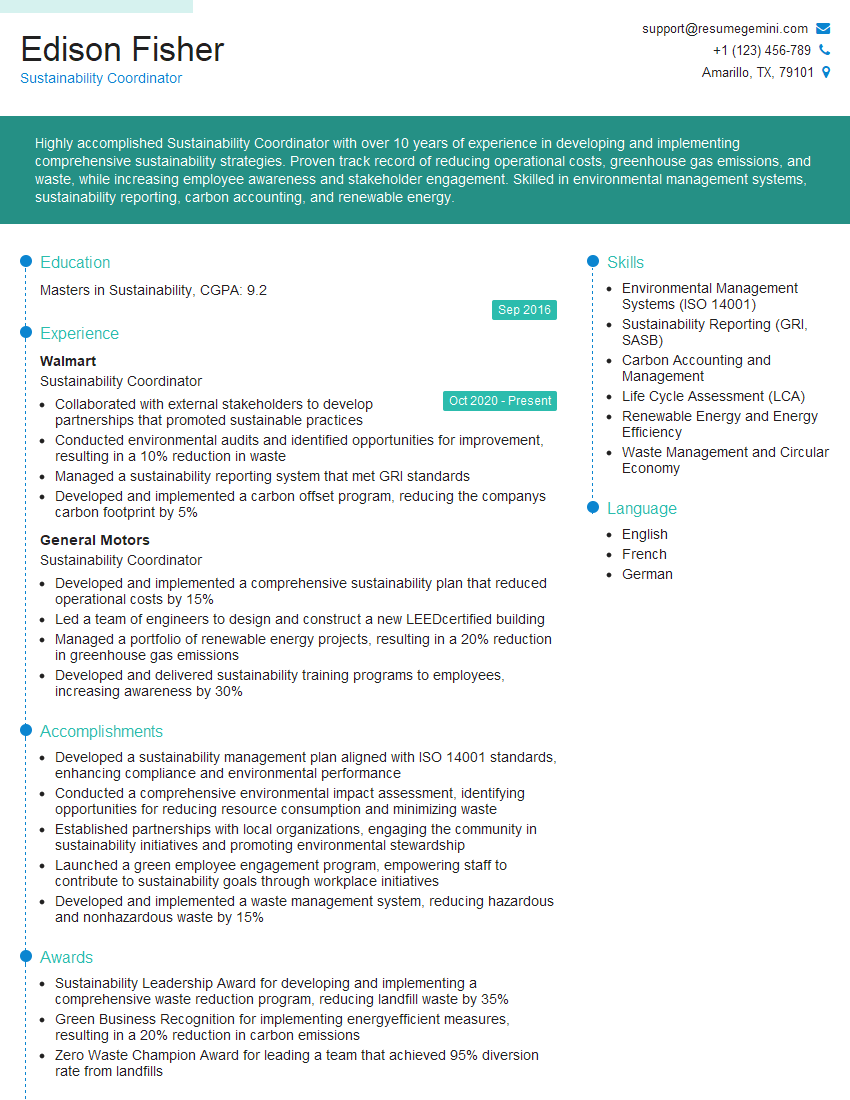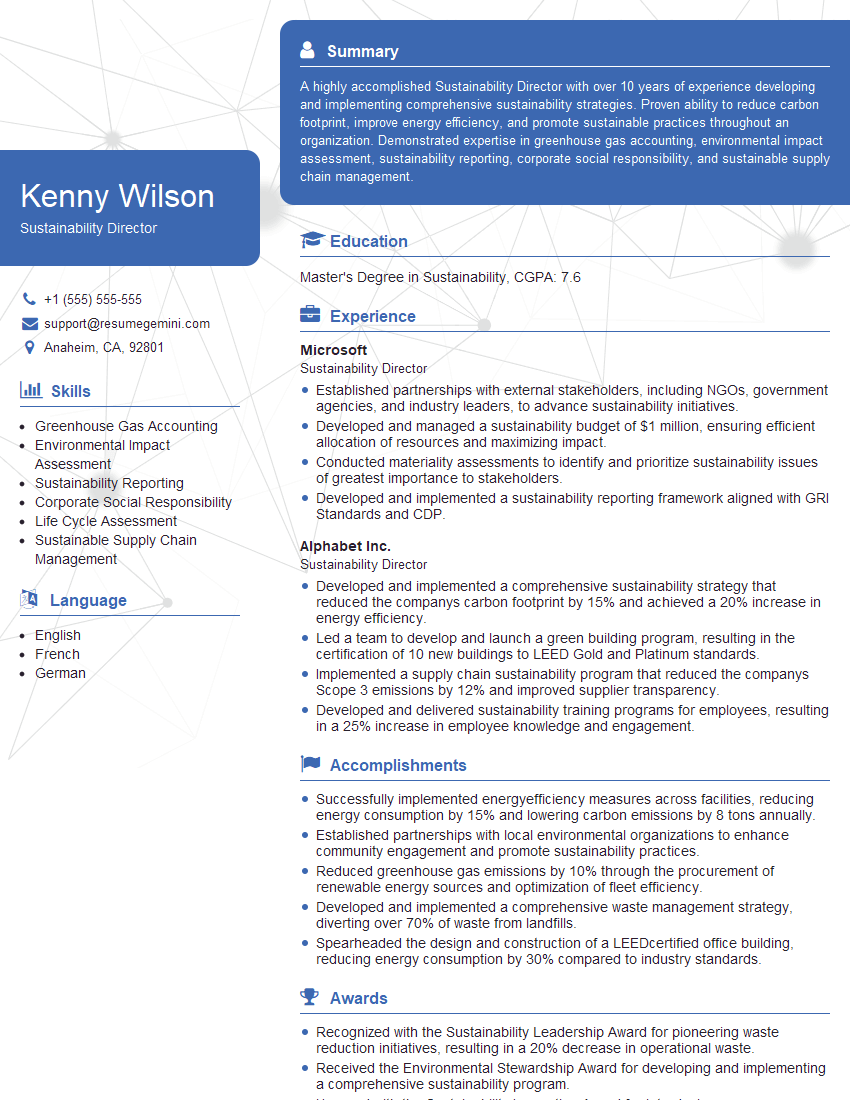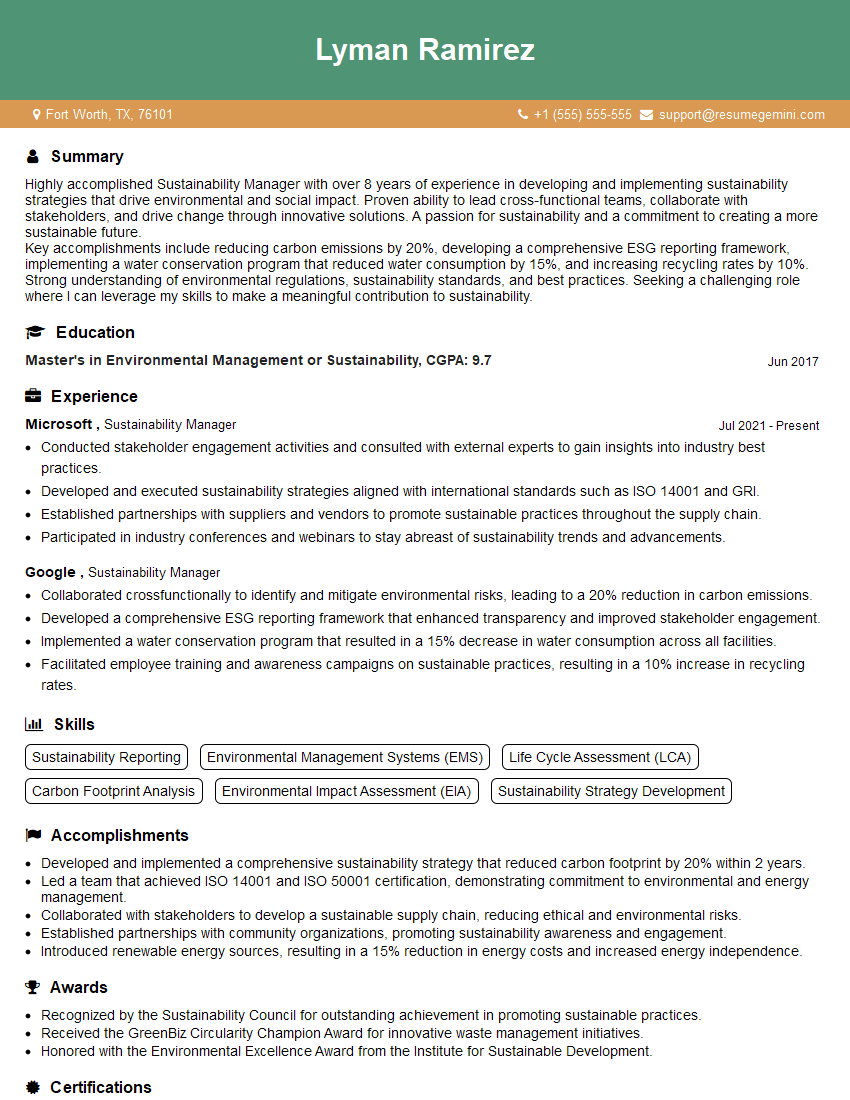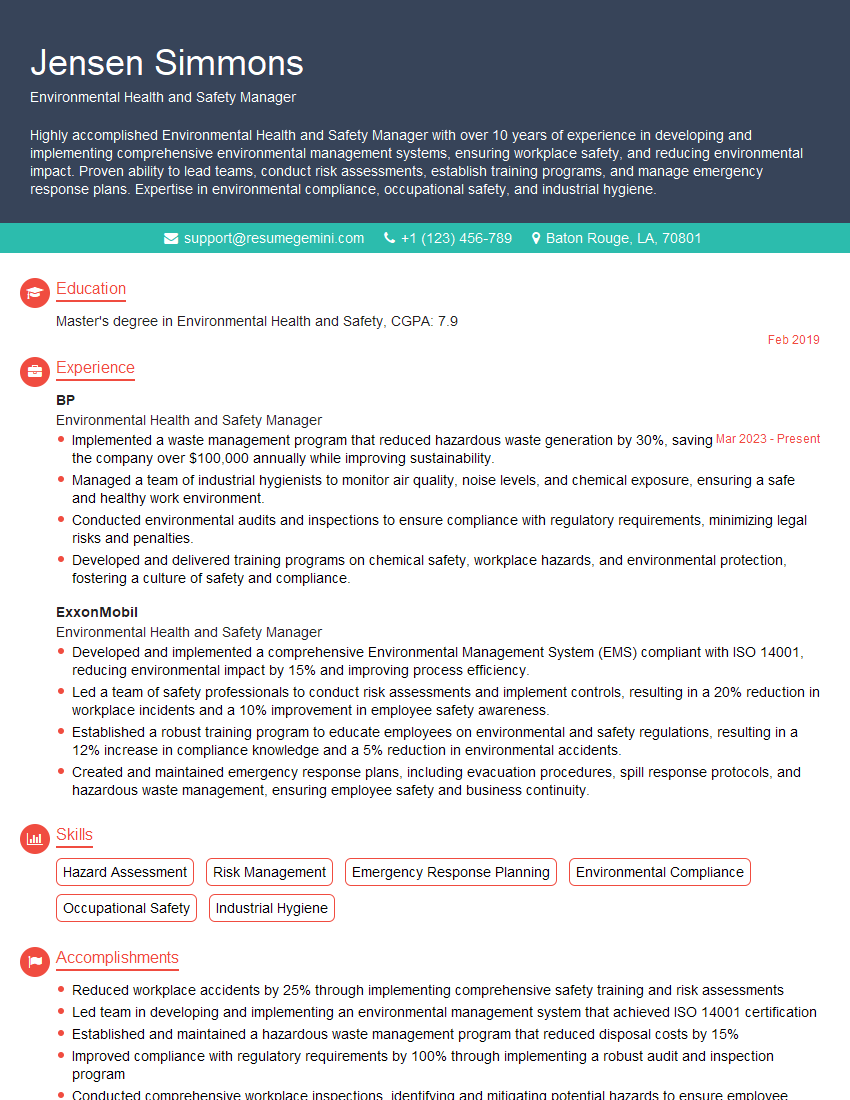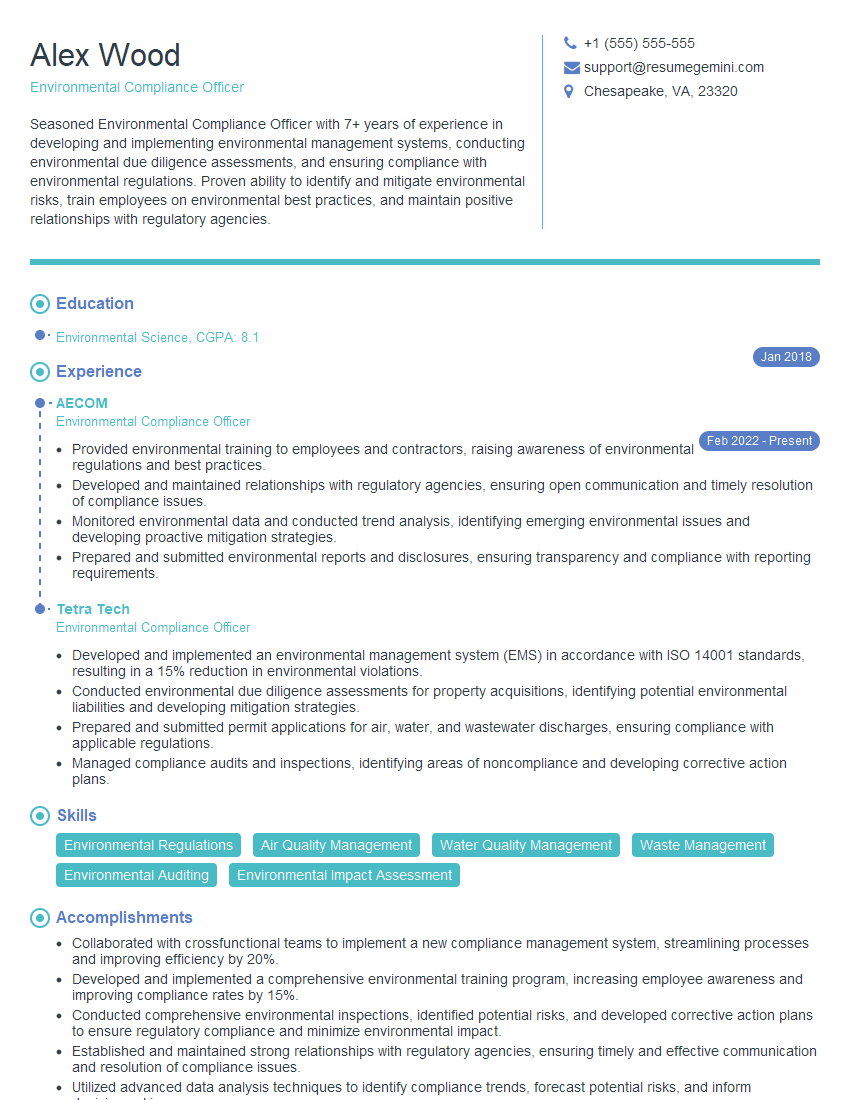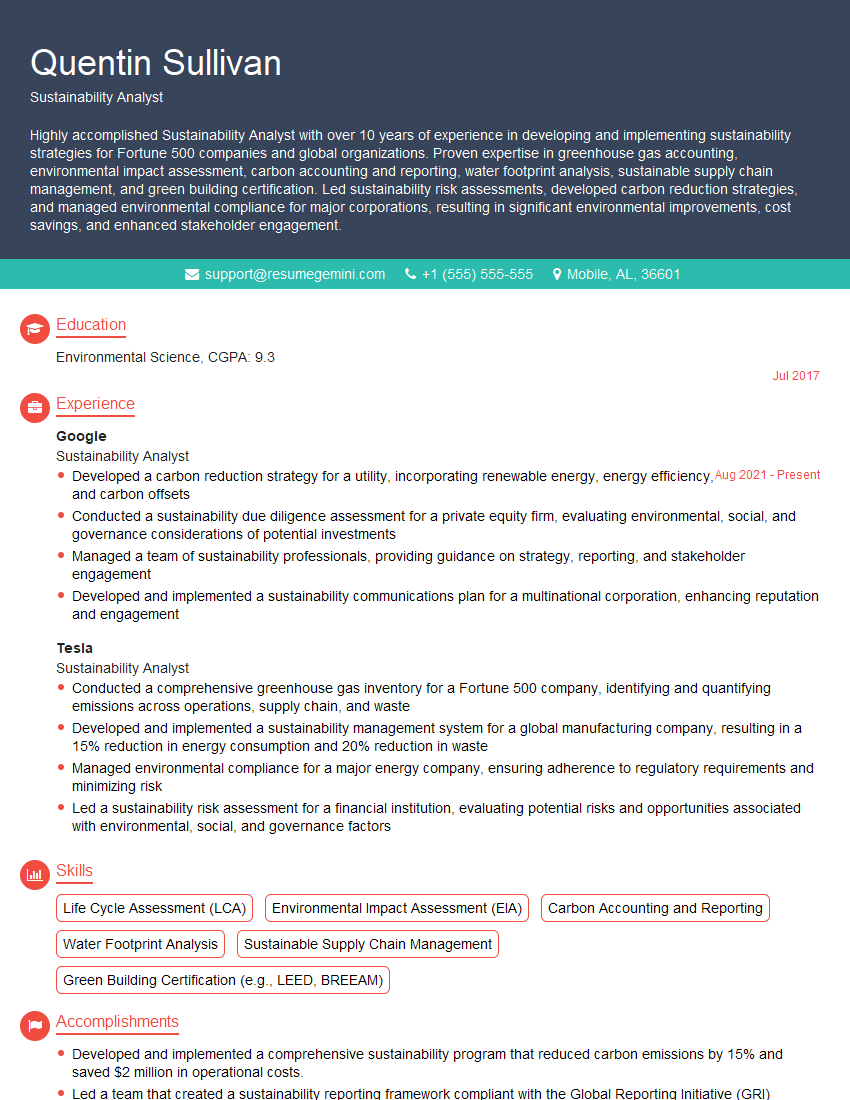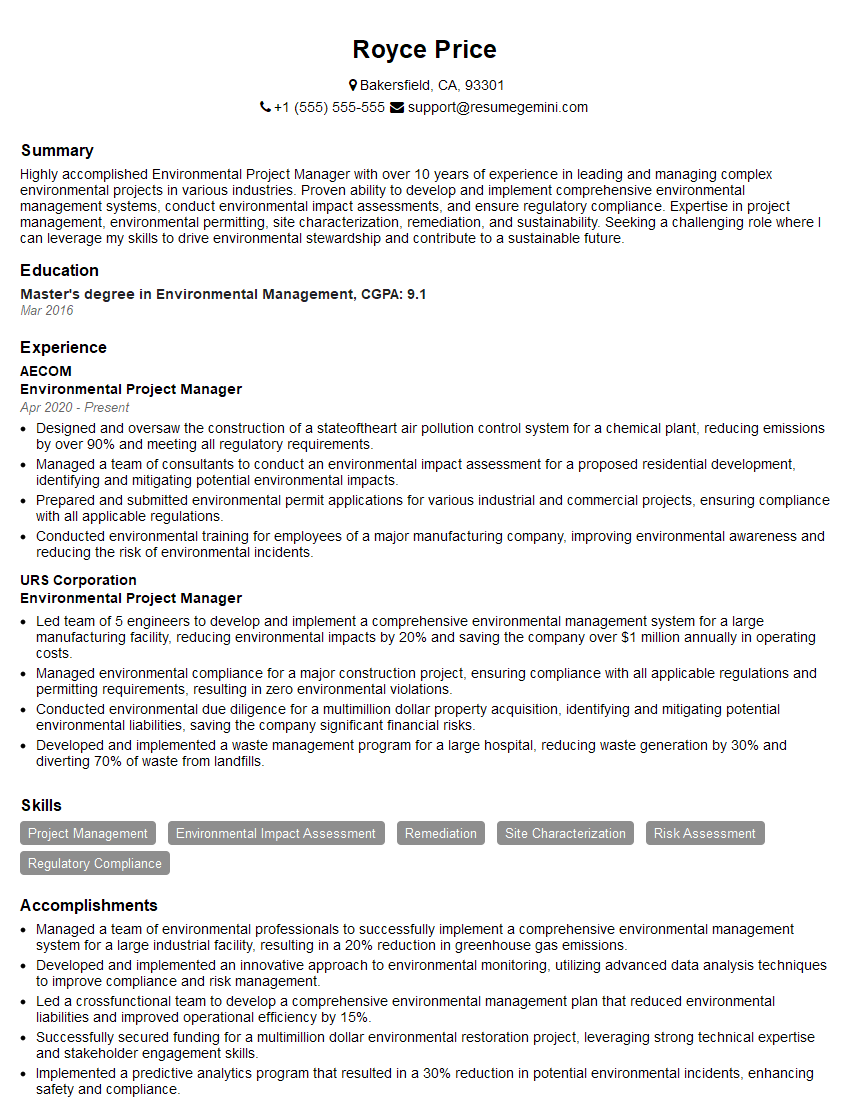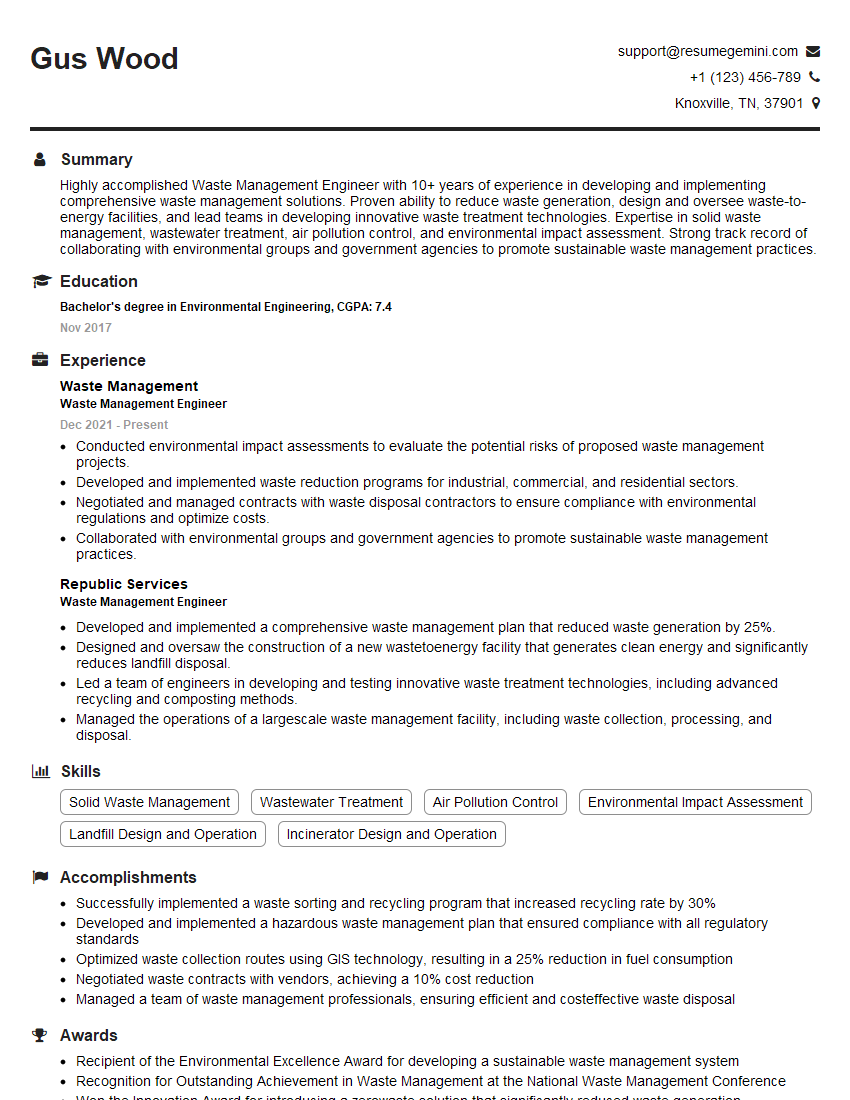Unlock your full potential by mastering the most common Zero Waste Strategies interview questions. This blog offers a deep dive into the critical topics, ensuring you’re not only prepared to answer but to excel. With these insights, you’ll approach your interview with clarity and confidence.
Questions Asked in Zero Waste Strategies Interview
Q 1. Define the five R’s of waste management.
The five R’s of waste management – Refuse, Reduce, Reuse, Recycle, and Rot – represent a hierarchical approach to minimizing waste. It prioritizes preventing waste generation in the first place over downstream solutions.
- Refuse: Say no to unnecessary items. Think before you buy – do you really need it? This is the most impactful ‘R’.
- Reduce: Minimize consumption. Buy in bulk to reduce packaging, choose products with minimal packaging, and avoid single-use items.
- Reuse: Find creative ways to repurpose items. Use glass jars for storage, repurpose clothing, or donate items instead of throwing them away.
- Recycle: Properly sort and recycle materials according to local guidelines. This helps conserve resources and reduce landfill burden.
- Rot (Compost): Compost food scraps, yard waste, and other organic materials to create nutrient-rich soil. This reduces landfill waste and creates a valuable resource.
Imagine a family deciding to bring reusable water bottles instead of buying plastic ones every day (Reduce/Reuse). This small change drastically reduces their waste footprint compared to simply recycling the plastic bottles (Recycle) – demonstrating the hierarchy of the 5 R’s.
Q 2. Explain the concept of a circular economy.
A circular economy is a regenerative system where resources are kept in use for as long as possible, extracting maximum value from them while in use, then recovering and regenerating products and materials at the end of each service life.
Instead of a linear ‘take-make-dispose’ model, a circular economy embraces three core principles:
- Design out waste and pollution: Products are designed for durability, repairability, and recyclability from the outset.
- Keep products and materials in use: Through reuse, repair, refurbishment, and remanufacturing.
- Regenerate natural systems: By using renewable energy sources and promoting biodiversity.
For example, a company might design a phone with easily replaceable batteries and modular components, making it easy to repair and extend the phone’s lifespan. At the end of its life, the materials are recovered and reused in new products, closing the loop.
Q 3. What are the key performance indicators (KPIs) used to measure the success of a zero waste program?
Key Performance Indicators (KPIs) for a zero waste program track progress towards waste reduction goals. These can include:
- Waste Diversion Rate: The percentage of waste diverted from landfills through recycling, composting, and other methods.
(Total Waste Diverted / Total Waste Generated) * 100 - Waste Generation per Capita/Employee: Measures waste production per person or employee, helping identify areas for improvement.
- Recycling Rate: The percentage of recyclable materials actually recycled.
- Composting Rate: The percentage of compostable materials composted.
- Landfill Diversion Rate: The percentage of waste that does *not* go to landfill.
- Cost Savings from Waste Reduction: Quantifies the financial benefits of reduced waste disposal fees and increased resource recovery.
Tracking these KPIs helps organizations monitor their progress, identify bottlenecks, and make data-driven decisions to enhance their zero waste efforts.
Q 4. Describe different waste diversion strategies.
Waste diversion strategies aim to keep materials out of landfills. They include:
- Source Reduction: Preventing waste generation at the source, such as reducing packaging or using reusable containers.
- Recycling and Composting: Processing materials for reuse or creating compost from organic waste.
- Waste-to-Energy: Incinerating waste to generate energy, though this isn’t ideal as it still releases emissions.
- Anaerobic Digestion: Breaking down organic waste in an oxygen-free environment to produce biogas.
- Repurposing and Reuse: Finding alternative uses for items instead of discarding them.
- Donation and Upcycling: Donating usable items to charities or transforming them into something new.
A restaurant might implement source reduction by switching to bulk food suppliers to reduce packaging, and then compost food scraps, achieving significant waste reduction.
Q 5. How do you conduct a waste audit?
A waste audit involves systematically examining the types and quantities of waste generated by an organization. It’s a crucial first step in developing effective zero waste strategies.
- Planning: Define the scope, timeframe, and objectives of the audit. Decide what waste streams will be examined.
- Data Collection: Weigh and categorize waste. This can be done by physically sorting waste or using pre-sorted bins.
- Data Analysis: Analyze the data to identify the types and quantities of waste, the sources of waste, and potential areas for improvement.
- Reporting: Create a report summarizing the findings, including recommendations for waste reduction strategies.
- Implementation: Put the recommendations into action and track progress over time.
For example, a manufacturing company might conduct a waste audit to discover that a significant portion of their waste is due to material defects. This information allows them to focus on improving their manufacturing processes to reduce waste at the source.
Q 6. What are the challenges in implementing zero waste strategies in different industries (e.g., manufacturing, food service)?
Implementing zero waste strategies faces unique challenges across industries:
- Manufacturing: Managing complex waste streams from various processes, achieving high recycling rates for diverse materials, and dealing with hazardous waste.
- Food Service: High volumes of organic waste, managing food spoilage, educating staff and customers about waste reduction practices, and dealing with food safety regulations.
- Healthcare: Handling medical waste safely, adhering to strict regulations, and managing a diverse range of waste types.
- Construction and Demolition: Recycling large volumes of construction materials, managing hazardous waste like asbestos, and coordinating with multiple contractors.
For example, a food service establishment might struggle with high organic waste if they don’t have a robust composting program or effective strategies for reducing food spoilage. In manufacturing, achieving high recycling rates for specialized materials can require significant investment in processing equipment.
Q 7. Explain the importance of stakeholder engagement in zero waste initiatives.
Stakeholder engagement is critical for the success of zero waste initiatives. It involves actively involving all relevant parties in the planning, implementation, and monitoring of the program.
Key stakeholders might include:
- Employees: Their participation is essential for successful waste reduction strategies in the workplace.
- Customers: Engaging customers in waste reduction efforts, such as providing reusable containers or encouraging them to bring their own bags, is vital.
- Suppliers: Working with suppliers to reduce packaging or use recycled materials can significantly impact the waste footprint.
- Local Government: Collaboration with local authorities is essential for accessing recycling services and navigating regulations.
- Community: Engaging the wider community can raise awareness and create a sense of collective responsibility.
Without effective stakeholder engagement, a zero waste initiative may encounter resistance, lack of participation, and ultimately, failure. For example, a successful recycling program requires employees to understand and follow the sorting guidelines and customers to willingly participate in the program.
Q 8. How do you prioritize waste reduction strategies?
Prioritizing waste reduction strategies requires a hierarchical approach, focusing on the most impactful actions first. This follows the waste hierarchy: Refuse, Reduce, Reuse, Repurpose, Recycle, Recover, and lastly, Dispose. I prioritize strategies based on their potential for the greatest environmental and economic benefit, starting with the top of the hierarchy and moving down.
- Refuse: Eliminating unnecessary items at the source is the most impactful. This involves strategic purchasing, minimizing packaging, and refusing single-use plastics. For example, advocating for bulk purchasing options within an organization or refusing promotional items.
- Reduce: Optimizing processes to minimize waste generation is next. This could involve redesigning packaging, improving efficiency in manufacturing processes, or minimizing material usage in product design.
- Reuse/Repurpose: Finding alternative uses for materials before disposal extends their lifespan. Repurposing office supplies or using food scraps for compost are examples.
- Recycle/Recover: Recycling diverts waste from landfills, but requires a robust system and consumer participation. Energy recovery from waste can also be considered but should be a lower priority than other strategies.
- Dispose: This should be the absolute last resort, focusing on safe and environmentally responsible disposal methods.
The prioritization process should also consider the feasibility and cost-effectiveness of each strategy, factoring in the available resources and the organization’s context. A cost-benefit analysis often helps in making informed decisions.
Q 9. Describe your experience with different composting methods.
I have extensive experience with various composting methods, ranging from simple backyard composting to large-scale industrial systems. My experience covers:
- Backyard Composting: I’ve worked with both traditional methods using bins and more advanced systems like tumblers, which expedite decomposition. The success of backyard composting depends heavily on maintaining the correct carbon-to-nitrogen ratio and moisture levels.
- In-vessel Composting: This method uses enclosed containers to manage the composting process, often utilizing aeration and temperature control for faster and more efficient decomposition. This is suitable for larger volumes of organic waste.
- Aerated Static Pile Composting: This method involves creating large piles of organic waste that are periodically aerated using specialized equipment. It’s less intensive than in-vessel composting but still manages the composting process effectively.
- Vermicomposting: Utilizing worms to break down organic matter is a highly efficient and effective method. It results in a nutrient-rich vermicompost, suitable for gardening.
Choosing the most appropriate composting method depends on the volume of waste, available resources, and desired outcome. For example, a small restaurant might opt for in-vessel composting, while a community garden could use vermicomposting.
Q 10. What are the benefits and limitations of anaerobic digestion?
Anaerobic digestion is a biological process where microorganisms break down organic matter in the absence of oxygen, producing biogas (primarily methane and carbon dioxide) and digestate (a nutrient-rich byproduct).
Benefits:
- Renewable Energy: Biogas can be used to generate electricity or heat, reducing reliance on fossil fuels.
- Waste Reduction: Significantly reduces the volume of organic waste sent to landfills, decreasing greenhouse gas emissions.
- Nutrient Recovery: Digestate is a valuable fertilizer, reducing the need for synthetic fertilizers.
- Odor Control: Properly managed anaerobic digestion systems significantly reduce odors associated with organic waste decomposition.
Limitations:
- High Capital Costs: Establishing an anaerobic digestion facility requires significant upfront investment.
- Process Complexity: Requires specialized knowledge and skilled operation to maintain optimal conditions for biogas production.
- Pre-treatment: Organic waste might need pre-treatment (size reduction, separation of inert materials) before being fed into the digester.
- Inhibitor Sensitivity: Certain substances can inhibit the anaerobic digestion process, requiring careful monitoring and control.
The suitability of anaerobic digestion depends heavily on the scale of the operation, the nature of the waste stream, and the availability of appropriate infrastructure.
Q 11. How do you measure and track waste reduction progress?
Tracking waste reduction progress involves a multi-faceted approach, combining quantitative and qualitative data. I use a combination of methods:
- Waste Audits: Regular waste audits provide baseline data and track changes over time. This involves carefully weighing and categorizing waste streams to identify areas for improvement.
- Waste Characterization Studies: Detailed analysis of waste composition helps identify the types and sources of waste, guiding targeted interventions.
- Data Logging and Reporting: Implementing a robust data management system, possibly including specialized software, is crucial for tracking key performance indicators (KPIs) like waste diversion rates, landfill avoidance, and recycling rates.
- Benchmarking: Comparing performance against industry best practices or similar organizations provides context and identifies areas for improvement.
- Visualizations: Using graphs and charts to display trends and progress helps communicate findings effectively to stakeholders.
For example, in a manufacturing plant, we could track the amount of waste generated per unit produced. Improvements in production efficiency or material usage would then be reflected in a reduction of this KPI. Regular reporting and analysis of these KPIs are key to continuous improvement.
Q 12. Explain your understanding of lifecycle assessment (LCA).
A lifecycle assessment (LCA) is a comprehensive analysis of the environmental impacts associated with a product or process, from its cradle (raw material extraction) to its grave (disposal). It considers impacts across its entire life cycle, including energy consumption, resource depletion, greenhouse gas emissions, and waste generation.
Stages of an LCA:
- Goal and Scope Definition: Clearly defining the objectives, system boundaries, and functional unit of the LCA.
- Inventory Analysis: Quantifying all inputs and outputs associated with the product or process.
- Impact Assessment: Evaluating the environmental impacts of the inputs and outputs using specific impact categories (e.g., global warming potential, eutrophication).
- Interpretation: Analyzing the results and drawing conclusions regarding the overall environmental performance.
LCAs are crucial in identifying hotspots of environmental impact within a product’s life cycle. This information can then be used to inform design improvements, material selection, and process optimization to minimize negative impacts. For instance, an LCA might reveal that a specific packaging material contributes disproportionately to greenhouse gas emissions, leading to a switch to a more sustainable alternative.
Q 13. Describe your experience with waste management software or tools.
I’ve worked with several waste management software and tools, including specialized platforms for waste tracking, auditing, and reporting. These tools typically include features for:
- Waste Data Collection: Facilitating data entry from various sources, such as weigh scales, waste audits, and manual inputs.
- Reporting and Analysis: Generating reports on waste generation, diversion rates, and other KPIs.
- Compliance Management: Assisting with regulatory compliance reporting.
- Data Visualization: Providing graphical representations of waste data to aid in decision-making.
Example Software Feature: A typical waste management software might allow for the creation of customized reports, showing waste generation trends by department or material type over time. This visual data helps identify areas where interventions would yield the greatest impact.
The selection of appropriate software depends on the size and complexity of the organization and its specific needs. Smaller organizations might use simpler spreadsheet-based systems, while larger enterprises often benefit from sophisticated, integrated platforms.
Q 14. How would you address resistance to change within an organization when implementing zero waste strategies?
Addressing resistance to change when implementing zero waste strategies requires a multi-pronged approach focused on communication, engagement, and demonstrating value.
Strategies:
- Communication and Education: Clearly communicate the benefits of zero waste, addressing concerns and misconceptions. This includes explaining the environmental and economic advantages, highlighting success stories from other organizations, and emphasizing the long-term vision.
- Employee Engagement: Involve employees in the process, providing training, fostering a sense of ownership, and seeking input on implementation strategies. This can involve setting up cross-functional teams, holding workshops, and creating employee recognition programs.
- Demonstrating Value: Quantify the benefits of zero waste initiatives, showcasing cost savings, improved efficiency, enhanced brand reputation, and environmental responsibility. Use data to support arguments and demonstrate the positive return on investment.
- Pilot Projects: Start with small-scale pilot projects to demonstrate the feasibility and benefits of zero waste strategies before full-scale implementation. This reduces risk and provides a platform for learning and improvement.
- Addressing Concerns: Actively listen to concerns and address them head-on. Acknowledge potential challenges and provide solutions. Emphasize that zero waste is a journey, not a destination, and iterative improvements are part of the process.
- Leadership Support: Secure buy-in and visible support from senior leadership to demonstrate the organization’s commitment and foster a culture of sustainability.
Building consensus and demonstrating that zero waste is beneficial for both the environment and the organization’s bottom line is crucial for successful implementation.
Q 15. What is your experience with regulatory compliance related to waste management?
Regulatory compliance in waste management is crucial for any zero waste initiative. My experience encompasses a deep understanding of various national and local regulations, including those pertaining to hazardous waste, recycling mandates, and landfill diversion targets. I’ve worked directly with agencies like the EPA (in the US context) and equivalent bodies in other regions to ensure full compliance. This includes conducting waste audits, implementing appropriate record-keeping systems, and developing and executing compliance plans. For example, in a previous role, we successfully navigated the complexities of California’s SB 1383 organic waste reduction regulations, resulting in a significant decrease in landfill waste and a substantial increase in composting and anaerobic digestion.
I’m familiar with the legal implications of non-compliance, including potential fines and legal repercussions, and proactively implement strategies to avoid them. This involves staying up-to-date on legislative changes, training personnel on relevant regulations, and regularly reviewing our waste management practices to maintain compliance. Understanding these regulations isn’t just about avoiding penalties; it’s about ensuring environmental responsibility and contributing to a sustainable future.
Career Expert Tips:
- Ace those interviews! Prepare effectively by reviewing the Top 50 Most Common Interview Questions on ResumeGemini.
- Navigate your job search with confidence! Explore a wide range of Career Tips on ResumeGemini. Learn about common challenges and recommendations to overcome them.
- Craft the perfect resume! Master the Art of Resume Writing with ResumeGemini’s guide. Showcase your unique qualifications and achievements effectively.
- Don’t miss out on holiday savings! Build your dream resume with ResumeGemini’s ATS optimized templates.
Q 16. How do you manage and communicate progress reports on a zero waste initiative?
Managing and communicating progress on a zero waste initiative requires a multi-faceted approach. First, we establish clear, measurable, achievable, relevant, and time-bound (SMART) goals. These targets are communicated transparently to all stakeholders, from employees and management to clients and the community. We use a combination of tools to track progress, including waste audits, data dashboards, and specialized waste management software. These systems allow for real-time monitoring of key metrics like waste diversion rates, recycling percentages, and hazardous waste generation.
Regular progress reports are crucial. These reports include both quantitative data (e.g., tons of waste diverted, reduction in landfill waste) and qualitative data (e.g., employee feedback on training, challenges encountered, and successes achieved). Reports are tailored to the audience, ensuring clear and concise communication of key findings and actionable insights. Visual aids like graphs and charts are essential for effectively presenting complex data. For instance, in a recent project, we used interactive dashboards to showcase the progress of our zero waste strategy, which increased employee engagement and buy-in to the initiative. Effective communication also includes celebrating milestones and acknowledging successes along the way, which encourages continued commitment to the zero waste journey.
Q 17. Describe your experience with designing and implementing waste reduction training programs.
Designing and implementing effective waste reduction training programs is a key component of a successful zero waste strategy. My approach involves a needs assessment, understanding the specific waste challenges within the organization, and tailoring the training content accordingly. This includes identifying knowledge gaps, skills deficits, and behavioral patterns that contribute to waste generation. Training modules incorporate a variety of methods, including interactive workshops, online modules, and on-the-job coaching.
For example, I once developed a comprehensive training program that focused on source reduction, waste segregation, and proper recycling techniques. The program involved interactive sessions, hands-on activities, and case studies to illustrate the practical application of zero waste principles. Post-training assessments are vital to evaluate the effectiveness of the program and identify areas for improvement. We also encourage continuous learning and improvement through regular updates and refresher courses. The aim is to instill a culture of environmental responsibility, making zero waste a part of everyday operations.
Q 18. What are the key considerations for designing a zero waste facility?
Designing a zero waste facility requires a holistic approach, considering various factors from the initial design phase to daily operations. Key considerations include:
- Location and Infrastructure: Proximity to recycling facilities and composting infrastructure is essential to minimize transportation costs and maximize diversion rates.
- Building Design: The building itself should be designed for efficient waste management. This includes dedicated areas for waste sorting, storage, and collection; optimized material selection to minimize waste generation; and efficient waste handling systems.
- Process Design: Production processes should be optimized to minimize waste generation through lean manufacturing principles, design for disassembly, and reuse of materials.
- Waste Segregation and Handling: A robust waste segregation system is critical. Clearly labeled bins, training, and a well-defined waste stream management plan are essential to ensure proper sorting and collection of materials.
- Technology Integration: Incorporating technologies like automated sorting systems, balers, and compactors can enhance efficiency and improve waste diversion rates.
- Data Management and Monitoring: Real-time data collection and analysis is crucial for tracking progress, identifying areas for improvement, and ensuring continuous improvement.
For instance, a zero-waste manufacturing plant might integrate closed-loop systems, reusing process water and recovering valuable materials from waste streams. This creates a circular economy model, reducing both waste and environmental impact.
Q 19. How do you incorporate zero waste principles into procurement and supply chain management?
Incorporating zero waste principles into procurement and supply chain management is critical for achieving meaningful reductions in waste generation. This starts with specifying sustainable and environmentally friendly products and materials. It involves collaborating with suppliers to choose products with minimal packaging, recycled content, and long lifespans. This requires a shift in thinking from focusing solely on cost to considering the entire life cycle of a product and its environmental footprint.
We implement sustainable procurement policies that prioritize products with recycled content, minimal packaging, and low embodied carbon. We actively engage with suppliers to encourage them to adopt more sustainable practices. For instance, we may request lifecycle assessments (LCAs) of materials to evaluate their environmental impact. We also foster strong relationships with local suppliers, minimizing transportation distances and carbon emissions. By integrating zero waste considerations into the selection and purchasing process, we can significantly reduce the environmental impact of our operations and contribute to a more sustainable supply chain.
Q 20. Explain your experience with different recycling technologies and their applications.
My experience encompasses a range of recycling technologies. These include:
- Mechanical Recycling: This involves processes like shredding, sorting, and separating materials using various mechanical methods. It’s commonly used for plastics, metals, and paper.
- Chemical Recycling: This uses chemical processes to break down materials into their base components, allowing for the creation of new products. It’s increasingly important for plastics that are difficult to mechanically recycle.
- Biological Recycling (Composting and Anaerobic Digestion): This involves the use of microorganisms to break down organic waste, producing compost or biogas. This is crucial for organic waste streams such as food scraps and yard waste.
The choice of technology depends on the type of waste, its composition, and the desired outcome. For example, a facility recycling mixed plastics may use a combination of mechanical sorting followed by chemical recycling for specific plastic types that are difficult to recycle mechanically. Understanding these technologies and their applications is vital for designing efficient and effective recycling systems and maximizing waste diversion rates.
Q 21. How do you handle hazardous waste in a zero waste framework?
Handling hazardous waste within a zero waste framework requires a meticulous and specialized approach. The core principle is to minimize hazardous waste generation at the source, through process optimization and substitution of hazardous materials with safer alternatives. This often involves a combination of strategies:
- Source Reduction: Identifying and eliminating hazardous materials throughout the production process is a primary focus. This might include switching to less toxic chemicals or redesigning processes to generate less hazardous byproducts.
- Waste Minimization: Implementing best practices to reduce the quantity of hazardous waste generated, such as proper housekeeping, preventative maintenance, and regular equipment inspections.
- Treatment and Recycling: Employing appropriate technologies to treat or recycle hazardous waste wherever feasible. This may involve specialized processes for specific hazardous materials, such as neutralization or incineration with energy recovery.
- Disposal: In cases where treatment or recycling is not feasible, disposal must comply with all relevant regulations, often involving specialized licensed facilities.
- Record Keeping and Reporting: Meticulous record-keeping is essential to track hazardous waste generation, management, and disposal. This is crucial for compliance with regulatory requirements.
Working with hazardous waste demands a high level of expertise and strict adherence to safety protocols. Any hazardous waste management program must prioritize safety and environmental protection at every step.
Q 22. How do you communicate the benefits of zero waste initiatives to different stakeholders?
Communicating the benefits of zero waste initiatives requires tailoring the message to the specific audience. For example, executives are typically motivated by cost savings, improved brand reputation, and enhanced operational efficiency. I would highlight the potential for reduced waste disposal fees, increased resource recovery, and improved supply chain resilience. For employees, the focus shifts to workplace improvements, such as a cleaner, safer environment, opportunities for professional development in sustainability, and a sense of collective purpose in contributing to a positive environmental impact. Customers are often drawn to a company’s commitment to sustainability, viewing zero waste practices as a sign of responsible corporate citizenship. I would emphasize the environmental benefits, the quality and longevity of products, and the reduced environmental footprint.
- Executives: ROI calculations, case studies of similar companies, and presentations focusing on bottom-line impact.
- Employees: Training programs, internal communication campaigns, and recognition for achievements in waste reduction.
- Customers: Transparent communication on sustainability efforts, highlighting the use of recycled materials and reduced packaging, and engaging in social media campaigns promoting environmental responsibility.
Q 23. What are some common barriers to achieving zero waste and how can they be overcome?
Common barriers to achieving zero waste include lack of awareness and understanding, high initial investment costs, resistance to change within organizations, lack of supportive infrastructure (e.g., recycling facilities), and inadequate data collection and monitoring systems.
To overcome these barriers, we need a multi-pronged approach. Education and training programs can raise awareness. Life-cycle cost analysis can demonstrate that long-term savings often outweigh upfront investments. Engaging employees early in the process and highlighting the benefits of zero waste fosters buy-in. Collaborating with local governments and waste management companies can help establish necessary infrastructure. Finally, robust data collection and monitoring systems provide insights into waste generation patterns and enable tracking of progress, facilitating continuous improvement.
For example, in a previous project, we addressed resistance to change by first conducting thorough waste audits and then presenting compelling data illustrating the potential cost savings and operational efficiencies that could be achieved through waste reduction initiatives. This approach transformed skepticism into enthusiasm and helped build momentum.
Q 24. Describe your approach to continuous improvement in a zero waste program.
Continuous improvement in a zero waste program relies on a cycle of Plan-Do-Check-Act (PDCA). We begin by planning, setting measurable goals, and developing strategies for waste reduction. The doing phase involves implementing the strategies, collecting data on waste generation, and conducting regular audits. The checking phase entails analyzing data, assessing progress towards goals, and identifying areas for improvement. Finally, the acting phase involves implementing corrective actions, refining strategies, and adapting to new challenges.
This cycle is not linear; feedback from each stage informs the next, creating a dynamic process of continuous refinement. For instance, regularly scheduled waste audits reveal trends and potential problem areas. Analysis of this data might reveal an unexpectedly high volume of a specific type of waste. We can then investigate the cause and implement solutions such as changing procurement practices, improving employee training, or exploring alternative waste management options.
Q 25. What are your thoughts on the future of zero waste management?
The future of zero waste management is driven by several key trends: increasingly stringent regulations, growing consumer demand for sustainable products and services, and advancements in technology. We’ll see more widespread adoption of Extended Producer Responsibility (EPR) programs, incentivizing manufacturers to design for recyclability and reduce waste at the source. Technological advancements, such as improved sorting technologies and innovative recycling methods, will enable us to recover and reuse a broader range of materials. Furthermore, the circular economy will play a crucial role, emphasizing the reuse, repair, and remanufacturing of products to minimize waste and maximize resource utilization. I anticipate a greater focus on data-driven decision making, leveraging digital technologies to optimize waste management processes and track performance effectively.
Q 26. How familiar are you with ISO 14001 or other relevant environmental management standards?
I am very familiar with ISO 14001, the internationally recognized standard for environmental management systems. It provides a framework for organizations to systematically manage their environmental impacts. My experience includes assisting companies in achieving ISO 14001 certification, helping them establish and implement environmental policies, and tracking their environmental performance. I am also knowledgeable about other relevant standards, such as those focused on specific waste streams (e.g., hazardous waste management) and those pertaining to life cycle assessments. Understanding these standards is crucial for developing robust and effective zero waste programs that meet regulatory requirements and demonstrate a commitment to environmental stewardship.
Q 27. Explain your understanding of Extended Producer Responsibility (EPR).
Extended Producer Responsibility (EPR) is a policy approach that holds producers accountable for the entire life cycle of their products, including their end-of-life management. Instead of solely relying on consumers or municipalities to manage waste, EPR shifts responsibility upstream to the producers. This often involves producers paying fees or participating in take-back programs for their products at the end of their useful life. The aim is to incentivize the design of more sustainable, recyclable, and reusable products, minimizing waste generation and promoting resource recovery. EPR programs have proven effective in reducing waste, stimulating innovation in product design, and funding improved recycling infrastructure.
Q 28. Describe a situation where you had to overcome a significant challenge related to waste reduction.
In a previous role, I faced a significant challenge involving a large manufacturing facility with a high volume of mixed waste. Initial efforts to implement source separation and recycling programs faced strong resistance from employees who were accustomed to traditional waste disposal practices. To overcome this, I implemented a multi-faceted approach. First, we conducted a series of workshops and training sessions to educate employees on the benefits of recycling and the proper sorting procedures. We also simplified the sorting process by providing clear labeling and color-coded bins. Secondly, we introduced a robust incentive program to reward employees for participation and consistently high recycling rates. Finally, we established regular progress reports and feedback sessions to address concerns and improve the program continuously. Through this combination of education, simplification, incentives, and open communication, we successfully increased recycling rates from 15% to over 70% within two years.
Key Topics to Learn for Zero Waste Strategies Interview
- Waste Reduction Hierarchy: Understand the principles of refuse, reduce, reuse, repurpose, recycle, and rot, and their practical application in various contexts.
- Life Cycle Assessment (LCA): Analyze the environmental impact of products and processes from cradle to grave, identifying opportunities for waste minimization.
- Waste Audits and Data Analysis: Learn to conduct waste audits, interpret data, and identify key areas for improvement in waste management strategies.
- Waste Diversion Strategies: Explore various methods for diverting waste from landfills, including composting, anaerobic digestion, and material recovery.
- Circular Economy Principles: Understand the core concepts of the circular economy and how it relates to zero waste strategies, focusing on resource efficiency and waste minimization.
- Policy and Legislation: Familiarize yourself with relevant environmental regulations and policies related to waste management and zero waste initiatives.
- Stakeholder Engagement and Communication: Understand the importance of effective communication and collaboration with different stakeholders in implementing zero waste programs.
- Technological Advancements: Explore innovative technologies in waste management, such as waste-to-energy, advanced recycling techniques, and smart waste management systems.
- Sustainable Procurement and Design: Learn how sustainable procurement and product design can contribute to minimizing waste throughout the supply chain.
- Metrics and Reporting: Understand key performance indicators (KPIs) for measuring the success of zero-waste initiatives and how to effectively report on progress.
Next Steps
Mastering Zero Waste Strategies significantly enhances your career prospects in a growing field dedicated to environmental sustainability. To stand out, a strong, ATS-friendly resume is crucial. ResumeGemini is a trusted resource to help you build a compelling resume that showcases your skills and experience effectively. ResumeGemini provides examples of resumes tailored to Zero Waste Strategies, ensuring your application gets noticed. Take the next step toward your dream career by crafting a professional resume that highlights your expertise in this vital area.
Explore more articles
Users Rating of Our Blogs
Share Your Experience
We value your feedback! Please rate our content and share your thoughts (optional).
What Readers Say About Our Blog
Hi, I have something for you and recorded a quick Loom video to show the kind of value I can bring to you.
Even if we don’t work together, I’m confident you’ll take away something valuable and learn a few new ideas.
Here’s the link: https://bit.ly/loom-video-daniel
Would love your thoughts after watching!
– Daniel
This was kind of a unique content I found around the specialized skills. Very helpful questions and good detailed answers.
Very Helpful blog, thank you Interviewgemini team.
